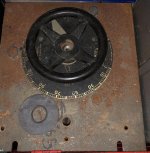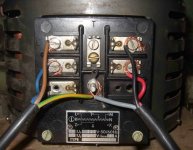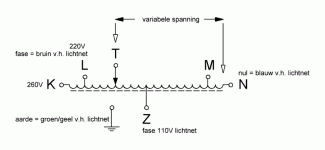I've been collecting bits and bobs through the years, but never had the space to use them till fairly recently. Some these bits are a variac and isolation transformer.
I've inspected the variac, looks like it has two adjustments, the big knob with a pointer and the plate beneath that which you can turn as well, it has a carbon brush.
Can any one tell me what that supposed to do?
I need to work out an enclosure for it, any ideas? The thing weighs about 6Kg, there are three screw hole on the bottom.






 https://ibb.co/jJ00d2w
https://ibb.co/jJ00d2w
I've inspected the variac, looks like it has two adjustments, the big knob with a pointer and the plate beneath that which you can turn as well, it has a carbon brush.
Can any one tell me what that supposed to do?
I need to work out an enclosure for it, any ideas? The thing weighs about 6Kg, there are three screw hole on the bottom.






 https://ibb.co/jJ00d2w
https://ibb.co/jJ00d2wA Variac allows AC line voltage adjustment, usually from 0-115% of nominal.
This is an autotransformer, it is NOT isolated from the AC line, be careful.
Look up the proper wiring for it, since these can be instantly destroyed by miswiring/misuse.
Fuse the output at no more than rated current.
This is an autotransformer, it is NOT isolated from the AC line, be careful.
Look up the proper wiring for it, since these can be instantly destroyed by miswiring/misuse.
Fuse the output at no more than rated current.
Last edited:
That was made by Philips.
My variac has three bolts bolting a plate to the top. The knob shaft protrudes through the mounting panel and the knob is fixed on the spindle.
It is rated at 500V/A as it the isolating transformer on each work bench.
No need for a fuse on the Variac as it is protected by the isolation transformer.
They are very useful and the G90 mark is for 90volts A/C to set up Philips G90 TVs. That was a while ago!
My variac has three bolts bolting a plate to the top. The knob shaft protrudes through the mounting panel and the knob is fixed on the spindle.
It is rated at 500V/A as it the isolating transformer on each work bench.
No need for a fuse on the Variac as it is protected by the isolation transformer.
They are very useful and the G90 mark is for 90volts A/C to set up Philips G90 TVs. That was a while ago!
Attachments
You MUST fuse the output (wiper) of the Variac, or any load problem will ruin the Variac permanently.
There is no safety margin.
There is no safety margin.
You MUST fuse the output (wiper) of the Variac, or any load problem will ruin the Variac permanently.
There is no safety margin.
Yes, I will. The output is rate for 8A.
I seem to remember I need to derate the power rating at low voltages. So Iout max is 8A, at 10v will be 80W. I'll be using a volt and current meter on the output.
The plate which is movable, with a carbon brush which traverses across the surface. I was thinking the pointer is the coarse AC Vout and the movable plate is a fine adjustment.
You can use any line voltage of 220VAC or less, but never exceed the 8A rating.
This is even rated for 50Hz, a very nice Variac. Be sure to connect the enclosure
that you will make directly to the utility safety ground as well.
This is even rated for 50Hz, a very nice Variac. Be sure to connect the enclosure
that you will make directly to the utility safety ground as well.
Last edited:
That was made by Philips.
My variac has three bolts bolting a plate to the top. The knob shaft protrudes through the mounting panel and the knob is fixed on the spindle.
It is rated at 500V/A as it the isolating transformer on each work bench.
No need for a fuse on the Variac as it is protected by the isolation transformer.
They are very useful and the G90 mark is for 90volts A/C to set up Philips G90 TVs. That was a while ago!
Hi Jon,
the variac is indeed made by Philips, it has a 8A rating at 240V, so a little under 2KVA.
I have an interest in tube gear, so I bought the variac and isolator mainly for that. Later I realised that I could've used 2 x work site transformers back-to-back; they're used in the construction industry to take the mains voltage from 240V to 120V, are well made, available up to 3.3KVA and cheap.
So if I've read the circuit correctly, I connect :
1) Mains earth to the metal chassis
2) mains in at L and N.
3) Vout will be from N and T.
I'll make a clear perspex guard and secure it at the two screws between the label.
1) Mains earth to the metal chassis
2) mains in at L and N.
3) Vout will be from N and T.
I'll make a clear perspex guard and secure it at the two screws between the label.
Looks like this photo may help. Or on second thoughts, maybe not!
Attachments
Last edited:
The schematic diagram in this link may be more helpful!
Aansluiten regeltrafo - Forum - Circuits Online
Aansluiten regeltrafo - Forum - Circuits Online
Galu, the first photo you posted doesn't look right to me. Only the earth connection looks correct.
The reference Dutch info looks about right.
The reference Dutch info looks about right.
Post #12 is more revealing of the purpose of the connections. The wiring is incorrect in the photo in post #11.

I wired it up:
1) Mains earth to the metal chassis
2) mains in at K and N.
3) Vout will from N and T.
With a 5A fuse on mains in.
Vout stayed at 120V no matter where I twisted the big knob.
Turned it off and then moved the plate below the knob to 45 mins, plugged it in. fuse blows.
The plate, not the knob seems to move the brush.
I'll get some more fuses or perhaps a circuit breaker before continuing.
Ok, I've worked out what's wrong.
The thick metal plate below the black knob is supposed to turn with the knob, at the moment the knob is spinning and not turning the plate. On closer inspection the plate is slightly warped. I've released the tension by adjusting it and it now turns a lot better. I'll see if I can flatten the plate. I'm surprised the spindle isn't slotted.
The thick metal plate below the black knob is supposed to turn with the knob, at the moment the knob is spinning and not turning the plate. On closer inspection the plate is slightly warped. I've released the tension by adjusting it and it now turns a lot better. I'll see if I can flatten the plate. I'm surprised the spindle isn't slotted.
> plugged it in. fuse blows.
you really should be experimenting with a 6V or 12V 1 Amp heater transformer, NOT directly across the line. Put 10 Ohms 10W resistor in series. If the resistor smokes you have a short. If you discover a connection to give a smooth 0-6V output, then try it on the wall. Even then I would start with a 100W incandescent lamp in series.
you really should be experimenting with a 6V or 12V 1 Amp heater transformer, NOT directly across the line. Put 10 Ohms 10W resistor in series. If the resistor smokes you have a short. If you discover a connection to give a smooth 0-6V output, then try it on the wall. Even then I would start with a 100W incandescent lamp in series.
Those variacs tend to have large or very large inrush current (because of few turns), so prepare a lot of fuses. If it is 8 A rated a fuse have to be at least 10 A, I think.I'll get some more fuses or perhaps a circuit breaker before continuing.
So it is good idea to use circuit breaker or/and large powerful (>20 mm) NTC, several Ohm value, to decrease this inrush current peak value.
Lot's of good information here gents.
@rayma thanks for the reminder that this IS an autotransformer, which
is not isolated from the mains.
Funny, when ever I switch mine on, I can always hear it "engergize" with that
energize noise for lack of a better description, but those of you that have heard
it you know what I mean, it like a weird springy vibration that only happens once
and with it the lights also dim briefly until the variac is fully energized.
I'll try and link to my wiki of my rebuild/clean up of mine.
Now, why am I posting here?
I was just using mine as I was bringing up a Dynaco ST-70 slowly, after
I did a dim bulb test (DBT) after undoing a screw up prior repair to it. Some how
it wouldn't bias up and lost bias diode, which seemed strange to me as it was
an FR157 in a bias circuit that I first tested at -60VDC. Then after replacing
leaky caps on the aftermarket SDS Labs capacitor board kit (some of the caps
were leaky)...Trying to bring it up first w/o tubes measuring then finding there would
be no bias, so checked diode and it tested okay in circuit.
But, I pulled it anyway and replaced it with one of those fancy ones that
Mark Johnson wrote about in Linear Audio, then check again w/o tubes
and had Source -80 VDC bias voltage w/o tubes, then in stages brought
it up with DBTer glowing as 4 EL34s, two 7199s and rectifier try to pull
about 1.2 amps through a 100 watt bulb.
Plugged it in the Variac and brought it up slowly, to 120v, Then started carefully
setting the bias of the tubes cool at 80mA per pair, which resulted in about 1.8 amps
being pulled at idle.
Let it rest there for a bit, and shut it down.
Then I was going to do another round of fine tuning bias adjustments and actually
measure the current drawn for each EL34 with my HP428B. Low and behold
the amp wouldn't power up...
The variac died without a sound.
Both output fuses were good, that is the 2A and 10A fuses on the output.
So, the only thing I can think of ( haven't looked yet) is that the On/OFF switch
much broken or one of the line wires split of broke off the the on/off switch.
When I get to looking I show what I find.
And getting to an earlier question, what IS the term used to describe
that "energize" sound?
Going to the wiki and searching for "variac" brought no results.
Searching google outside our site brought up the following: LINK
It's the link I was the link for which I was looking, for the variac, surprise 🙂
After editing and reading the post after PRRs, (Vovk Z) Maybe I should wire in one of those
fancy CL60 (varistor) in series with the on/off switch, which would "slow start" ease the inrush
current of the variac?
Would I want just one? On the Line in only?
or would I want two? One on the Line in AND one on the Neutral?
Thinking out loud here.
Isn't that smaller transformer above the OP 110, on the top of my linked variac and isolation
transformer built into the variac? Pics 2, 3 from the link. Pic 3
is enlargeable.
Cheers,
@rayma thanks for the reminder that this IS an autotransformer, which
is not isolated from the mains.
Funny, when ever I switch mine on, I can always hear it "engergize" with that
energize noise for lack of a better description, but those of you that have heard
it you know what I mean, it like a weird springy vibration that only happens once
and with it the lights also dim briefly until the variac is fully energized.
I'll try and link to my wiki of my rebuild/clean up of mine.
Now, why am I posting here?
I was just using mine as I was bringing up a Dynaco ST-70 slowly, after
I did a dim bulb test (DBT) after undoing a screw up prior repair to it. Some how
it wouldn't bias up and lost bias diode, which seemed strange to me as it was
an FR157 in a bias circuit that I first tested at -60VDC. Then after replacing
leaky caps on the aftermarket SDS Labs capacitor board kit (some of the caps
were leaky)...Trying to bring it up first w/o tubes measuring then finding there would
be no bias, so checked diode and it tested okay in circuit.
But, I pulled it anyway and replaced it with one of those fancy ones that
Mark Johnson wrote about in Linear Audio, then check again w/o tubes
and had Source -80 VDC bias voltage w/o tubes, then in stages brought
it up with DBTer glowing as 4 EL34s, two 7199s and rectifier try to pull
about 1.2 amps through a 100 watt bulb.
Plugged it in the Variac and brought it up slowly, to 120v, Then started carefully
setting the bias of the tubes cool at 80mA per pair, which resulted in about 1.8 amps
being pulled at idle.
Let it rest there for a bit, and shut it down.
Then I was going to do another round of fine tuning bias adjustments and actually
measure the current drawn for each EL34 with my HP428B. Low and behold
the amp wouldn't power up...
The variac died without a sound.
Both output fuses were good, that is the 2A and 10A fuses on the output.
So, the only thing I can think of ( haven't looked yet) is that the On/OFF switch
much broken or one of the line wires split of broke off the the on/off switch.
When I get to looking I show what I find.
And getting to an earlier question, what IS the term used to describe
that "energize" sound?
Going to the wiki and searching for "variac" brought no results.
Searching google outside our site brought up the following: LINK
It's the link I was the link for which I was looking, for the variac, surprise 🙂
After editing and reading the post after PRRs, (Vovk Z) Maybe I should wire in one of those
fancy CL60 (varistor) in series with the on/off switch, which would "slow start" ease the inrush
current of the variac?
Would I want just one? On the Line in only?
or would I want two? One on the Line in AND one on the Neutral?
Thinking out loud here.
Isn't that smaller transformer above the OP 110, on the top of my linked variac and isolation
transformer built into the variac? Pics 2, 3 from the link. Pic 3
is enlargeable.
Cheers,
Last edited:
- Home
- Design & Build
- Equipment & Tools
- Variacs


